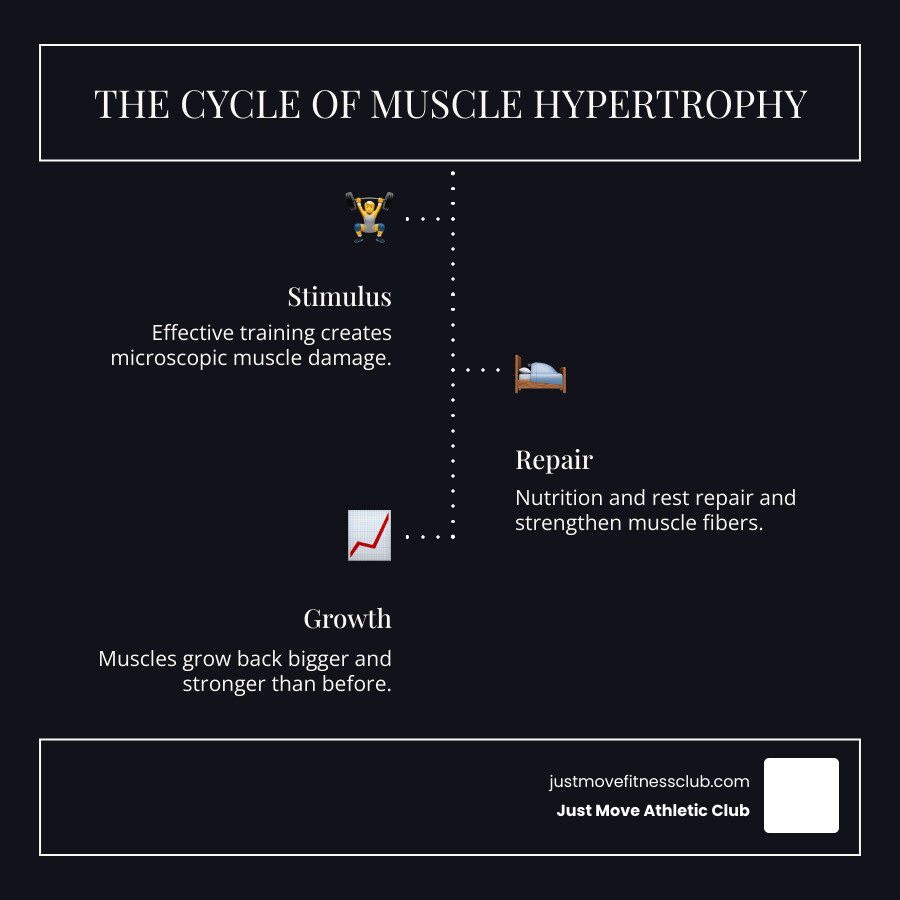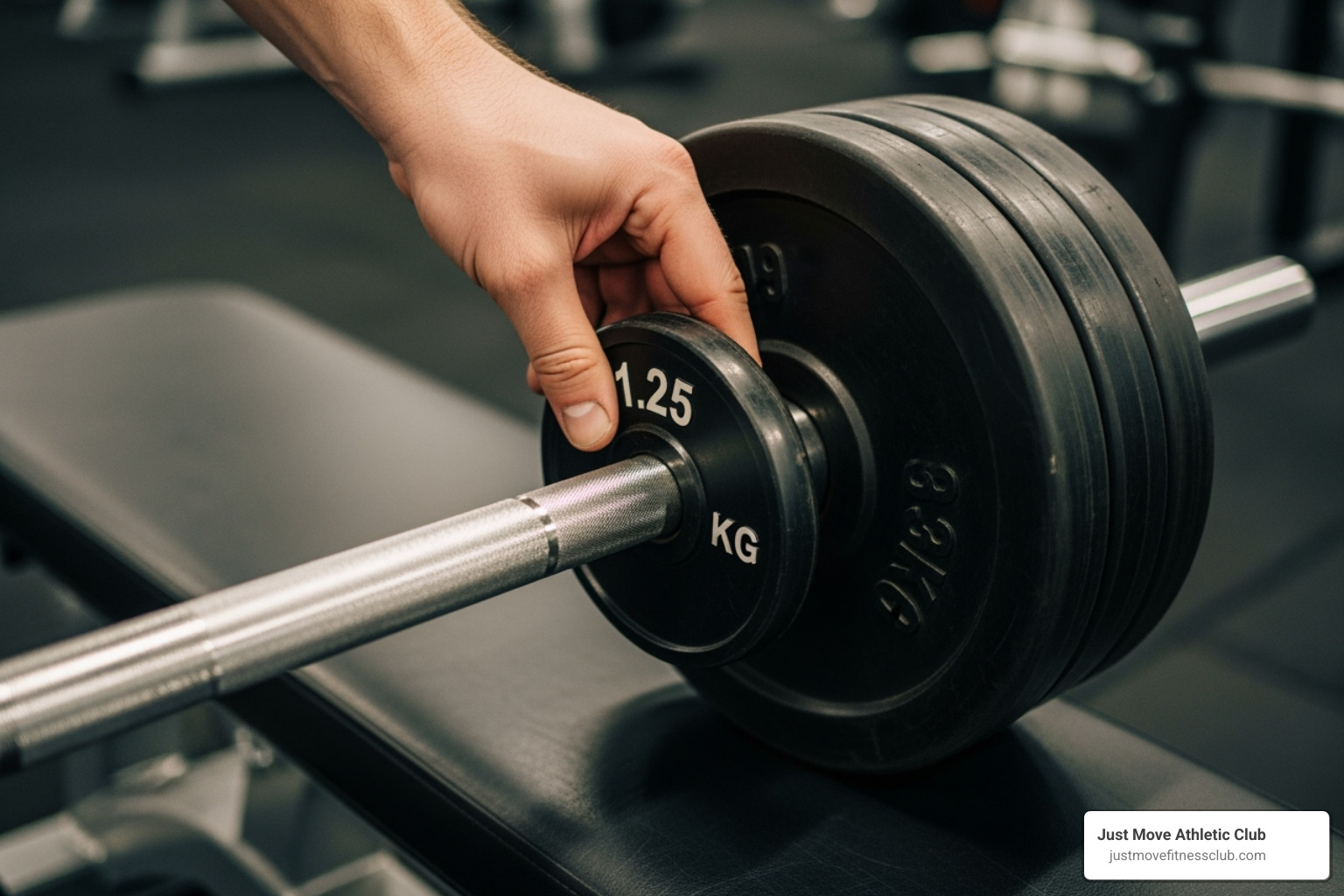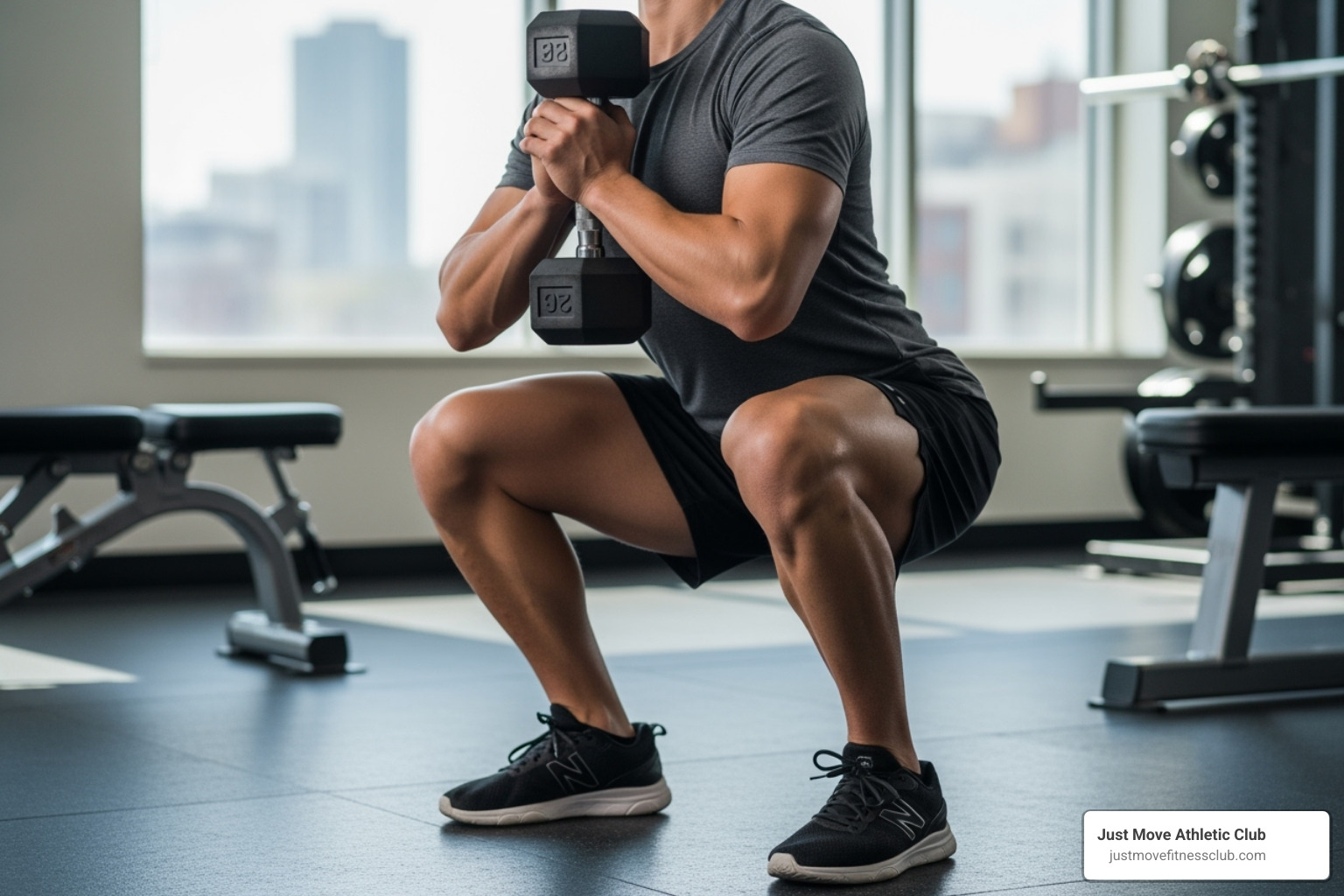Why a Structured Approach to Building Muscle Matters
A strength and muscle building workout plan is your roadmap to changing your physique and improving your health. An effective plan includes:
Key Components of an Effective Strength and Muscle Building Plan:
- Progressive overload – gradually increasing weight, reps, or sets over time
- Compound exercises – squats, deadlifts, bench press, rows as your foundation
- Training frequency – hitting each muscle group 2-3 times per week
- Proper rep ranges – 8-12 reps for muscle growth, 1-6 reps for strength
- Adequate recovery – rest days and 7-9 hours of sleep for muscle repair
- Nutrition support – slight calorie surplus with 1.4-2.2g protein per kg body weight
Many people fail to see results due to poor programming and bad form. As one fitness expert noted, “Most people fail to achieve their strength and muscle goals due to ridiculous exercise selection, poor programming, and bad form.” The difference between success and spinning your wheels is a structured plan.
Building muscle requires understanding basic principles like progressive overload—the gradual increase in training demands that drives growth. Research also shows that muscle mass is directly linked to longevity, better metabolism, and improved quality of life.
I’m Pleasant Lewis JMAC, and with over 40 years in the fitness industry, I’ve helped people transform their bodies through effective strength and muscle building workout plans. At Just Move Athletic Clubs, I’ve seen how the right combination of training, nutrition, and effort helps anyone build the strong, confident physique they’re after.

Simple strength and muscle building workout plan glossary:
The Core Principles of Building Muscle and Strength
Building muscle isn’t random; it’s science. Your strength and muscle building workout plan is a conversation with your body. Lifting weights creates microscopic tears in muscle fibers, which your body then repairs bigger and stronger—a process called hypertrophy. This happens through three main mechanisms: mechanical tension (the force from lifting), muscle damage (the micro-tears), and metabolic stress (the “burn” from intense sets). Scientific research on training volume suggests at least 10 sets per muscle group weekly for significant growth.
Understanding Progressive Overload
Progressive overload is the most critical principle: you must consistently ask more from your body. If you always lift the same weight for the same reps, your muscles won’t grow. Smart progressive overload isn’t just adding weight. You can also:
- Increase reps: Do more reps with the same weight.
- Increase sets: Add an extra set to an exercise.
- Improve form: Use stricter technique.
- Decrease rest time: Shorten breaks between sets.
A great tool is the 2-for-2 rule: if you can do two extra reps for two consecutive workouts, it’s time to increase the weight slightly (0.5-2 kg).

Exercise Selection: The Foundation of Your Plan
Not all exercises are equal. Compound exercises, which work multiple joints and muscles simultaneously, are the most efficient. The big players are squats, deadlifts, bench press, overhead press, rows, and pull-ups. They stimulate the most muscle in the least time. Isolation exercises like bicep curls or lateral raises are for targeting specific muscles and addressing weak points. A good plan combines both: compounds for the foundation, and isolation for refinement.
Top 5 Compound Lifts for Overall Growth:
- Squat (back squat, front squat, leg press variations)
- Deadlift (conventional, sumo, trap bar, Romanian deadlift)
- Bench Press (barbell, dumbbell, incline variations)
- Overhead Press (barbell, dumbbell, machine variations)
- Rows (barbell rows, dumbbell rows, cable rows, pull-ups)
Training Volume, Frequency, and Intensity
For muscle growth (hypertrophy), aim for 3-4 sets of 8-12 reps. For pure strength, work in the 1-6 rep range. You can build muscle with lighter weights as long as you’re training to near failure (leaving only 1-2 reps in the tank). Hit each muscle group 2-3 times per week for optimal growth. Rest 90-180 seconds for heavy compound lifts and 60-90 seconds for isolation exercises.
Choosing Your Ideal Strength and Muscle Building Workout Plan
Your ideal strength and muscle building workout plan depends on your experience, time, and goals. The plan’s structure is its training split. Popular splits include full body, upper/lower, and push/pull/legs. Be realistic about your commitment; consistency with a 3-day plan is better than inconsistency with a 5-day one.
| Split Type | Frequency (per muscle group) | Volume Potential | Ideal Experience Level |
|---|---|---|---|
| Full Body | 3x per week | Moderate | Beginner, Intermediate |
| Upper/Lower | 2x per week | High | Intermediate, Advanced |
| Push/Pull/Legs | 2x per week | High | Intermediate, Advanced |
Beginner Strength and Muscle Building Workout Plan (2-3 Days/Week)
If you’re new, a full-body routine 2-3 times per week is perfect. You’ll experience rapid “newbie gains” because your body responds quickly to new stimuli. Your top priority is mastering proper form. Start with manageable weights and focus on technique.
Full Body Workout (repeat 2-3 times per week):
- Barbell back squats: 3 sets of 8-12 reps
- Bench Press (barbell or dumbbell): 3 sets of 8-12 reps
- Seated cable rows: 3 sets of 8-12 reps
- Overhead Press (dumbbell or machine): 3 sets of 8-12 reps
- Bicep Curls: 2 sets of 10-15 reps
- Triceps Pushdowns: 2 sets of 10-15 reps
- Planks: 3 sets to failure

Intermediate Workout Plan (4 Days/Week)
After a few months, when newbie gains slow, an upper/lower split is a great next step. This 4-day routine allows for more volume and isolation work per muscle group while still hitting everything twice a week.
Monday – Upper Body:
- Bench Press or dumbbell incline press: 4 sets of 6-10 reps
- Barbell Rows: 4 sets of 6-10 reps
- Overhead Press: 3 sets of 8-12 reps
- Pull-ups or Lat Pulldowns: 3 sets of 8-12 reps
- Dumbbell Bicep Curls: 3 sets of 10-15 reps
- Overhead Triceps Extension: 3 sets of 10-15 reps
Tuesday – Lower Body:
- Squats or trap bar deadlifts: 4 sets of 6-10 reps
- Romanian Deadlifts: 3 sets of 8-12 reps
- Leg Press: 3 sets of 10-15 reps
- Leg Curls: 3 sets of 10-15 reps
- Calf Raises: 4 sets of 12-20 reps
- Ab Wheel Rollouts: 3 sets to failure
Rest on Wednesday, then repeat with slight variations on Thursday and Friday, including lateral raises for shoulder development.

Advanced Strength and Muscle Building Workout Plan (5-6 Days/Week)
For experienced lifters, a high-frequency, high-volume Push/Pull/Legs (PPL) split is highly effective. This 6-day routine allows for laser-focused intensity. Push days hit chest, shoulders, and triceps; Pull days target back and biceps; Legs days cover the lower body and core. Advanced lifters can use techniques like supersets (two exercises back-to-back) and dropsets (reducing weight to continue a set) to break through plateaus.
Day 1 – Push (Chest, Shoulders, Triceps):
- Barbell Bench Press: 4 sets of 5-8 reps
- Incline Dumbbell Press: 3 sets of 8-12 reps
- Dumbbell Shoulder Press: 3 sets of 8-12 reps
- Lateral Raises (superset with Front Raises): 3 sets of 12-15 reps each
- Cable rope triceps pushdowns: 4 sets of 10-15 reps
- Overhead Dumbbell Extension: 3 sets of 10-15 reps
Day 2 – Pull (Back, Biceps):
- Deadlifts or T-bar rows: 4 sets of 3-6 reps
- Weighted Pull-ups or Lat Pulldowns: 3 sets of 8-12 reps
- Barbell Rows: 3 sets of 8-12 reps
- Single-Arm Dumbbell Rows: 3 sets of 8-12 reps per arm
- Barbell Curls: 3 sets of 8-12 reps
- Incline Dumbbell Curls: 3 sets of 10-15 reps
Day 3 – Legs:
- Barbell Squats: 4 sets of 6-10 reps
- Romanian Deadlifts: 3 sets of 8-12 reps
- Leg Press: 3 sets of 10-15 reps
- Leg Extensions (superset with Leg Curls): 3 sets of 12-15 reps each
- Standing Calf Raises: 4 sets of 15-20 reps
- Hanging Leg Raises: 3 sets to failure
Repeat this cycle twice weekly with one rest day. This intensity requires excellent recovery and is not for beginners.

Fueling Your Gains: The Critical Role of Nutrition and Recovery
Even the best strength and muscle building workout plan fails without proper nutrition and recovery. Your workout is the stimulus; growth happens when you eat and sleep. You break down muscle in the gym and build it in the kitchen and bedroom. For muscle growth, a slight calorie surplus is ideal. However, body recomposition (building muscle while losing fat) is possible for beginners. This requires precise nutrition, focusing on key macronutrients. Protein builds muscle, carbs provide energy, and fats support hormone function. Sleep importance and active recovery are just as critical as your diet.
Nutrition for Muscle Growth
- Caloric Needs: Aim for a slight surplus of 250-500 calories above your daily maintenance level.
- Protein Intake: This is crucial. The International Society of Sports Nutrition protein guidelines recommend 1.4-2.0g per kg of body weight daily. Spread this intake throughout the day.
- Carbohydrates for Energy: Fuel your workouts with quality carbs like oats, rice, and fruits.
- Healthy Fats for Hormone Function: Fats from avocados, nuts, and olive oil are vital for hormones like testosterone.
- Hydration: Drink enough water to support performance and recovery.
The Power of Rest and Recovery
Muscle growth happens during recovery, not training.
- Sleep: Aim for 7-9 hours of sleep per night. This is when your body releases growth hormone and does most of its repair work.
- Rest Days: These are non-negotiable. Your muscles need time off to rebuild.
- Deload Weeks: Every 4-8 weeks, consider a deload week (reduced intensity or volume) to let your body fully recover.
- Managing Stress: Chronic stress raises cortisol, which can break down muscle. Find healthy ways to manage it.
- Active Recovery: On rest days, light activities like walking or stretching can speed up recovery by increasing blood flow.
- Overtraining Symptoms: Watch for persistent fatigue, declining performance, or mood changes. These are signs you need more rest.
Optimizing Your Routine and Avoiding Common Pitfalls
Success with your strength and muscle building workout plan requires optimizing your routine and avoiding common pitfalls. This means understanding equipment choices, cardio integration, and common mistakes that can derail progress.
Free Weights vs. Machines: Which is Better?
This isn’t an either-or question; the best approach uses both.
- Free weights (barbells, dumbbells) are superior for building functional strength and engaging stabilizer muscles. They allow for a natural range of motion, which is great for compound lifts like squats and deadlifts.
- Machines offer improved safety, especially when lifting to failure. They are excellent for isolation work and for learning proper form due to their fixed movement paths.
A study comparing free weights and machines found both are effective. A smart strategy is to start workouts with heavy, free-weight compound exercises and finish with machines for targeted volume and safety.
Integrating Cardio Without Killing Your Gains
Cardio won’t kill your gains if done correctly. In fact, it supports heart health, which aids recovery and overall performance.
- Stick to low-intensity steady-state cardio (LISS), like brisk walking or light cycling.
- Aim for 1-2 short sessions per week (20-30 minutes).
- Time it right: Do cardio after your weight training or on separate rest days to prioritize energy for lifting.
- Avoid excessive high-intensity cardio, as it can interfere with recovery and strength gains during a muscle-building phase.
Common Mistakes to Avoid
- Ego Lifting: Lifting more weight than you can handle with proper form. It leads to injury, not growth.
- Poor Form: This is the fastest way to get hurt. Perfect form with lighter weight is always better than sloppy form with heavy weight.
- Inconsistency: The best plan is the one you stick to. Consistency is more important than perfection.
- Program Hopping: Switching programs too often. Give a solid plan at least 8-12 weeks to work before making changes.
- Neglecting Nutrition: You cannot out-train a bad diet. Fuel your body properly with enough calories and protein.
- Insufficient Rest: Muscles grow during recovery, not training. Overtraining leads to fatigue and injury. Prioritize sleep and rest days.
Frequently Asked Questions about Building Strength and Muscle
Here are answers to some of the most common questions I get at Just Move Athletic Club about building muscle and strength.
How long does it take to see noticeable results?
If you’re new to training, you’ll experience “newbie gains” and feel stronger within a few weeks. Visible muscle changes typically appear in 6 to 12 weeks of consistent training and proper nutrition. Strength gains often come before significant size increases, so be patient. The key is consistency.
Can I build muscle while losing fat?
Yes, this is called body recomposition. It’s most effective for beginners or those returning from a long break. Success requires three things: a high protein diet (1.4-2.0g per kg of body weight), a slight calorie deficit (250-500 calories below maintenance), and consistent strength training with progressive overload. Evidence shows this is achievable under the right conditions.
Do I need to take supplements to build muscle?
Supplements are supplemental, not fundamental. A food first approach is always best. No supplement can replace a poor diet or inconsistent training. However, a few can be helpful:
- Protein Powder: A convenient way to help meet your daily protein goals.
- Creatine Monohydrate: The most researched supplement for improving strength and performance.
- Multivitamin: Can help fill any nutritional gaps in your diet.
The pillars are training, nutrition, and rest. Supplements are just extras.
Start Your Change Journey Today
We’ve covered the essentials for your strength and muscle building workout plan, from progressive overload to nutrition and recovery. The most important takeaways are that consistency and patience are your greatest assets, and a structured plan is non-negotiable. Random workouts don’t lead to consistent results.
At Just Move Athletic Club, we know starting can be tough. We provide a supportive environment and work with you to create a custom fitness experience. We help you track your progress with advanced tools like the Fit3D Pro Body Scanner, which provides detailed body composition data to precisely measure your results. Seeing your muscle gains and fat loss in precise detail is incredibly motivating.
With locations in Lakeland, North Lakeland, South Lakeland, Winter Haven, and Havendale, Florida, you have access to top-tier facilities and a community that cares. Building strength changes more than just your body—it changes your confidence and how you approach life’s challenges.
Ready to see real results? Join Just Move Athletic Club and start building the stronger you
